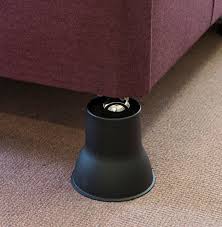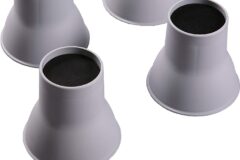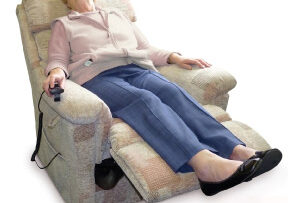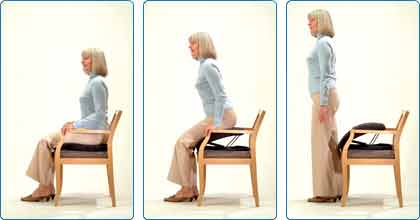If you spend many hours sitting in a chair it is very important that you have a chair that is carefully chosen to meet your individual needs. Your size, height, degree of mobility and any existing pain are some of the factors which can influence your choice of chair.
Standard chairs and chair accessories are generally regarded as daily living equipment. If you need to change your chair because of a disability your local authority may provide one on loan after an assessment by an occupational therapist or trained assessor. However, budget constraints make it impossible for many authorities to provide this sort of equipment so it is important to ask what you may be entitled to in your area.
Contact your local authority in England, Wales and Scotland, or your regional health and social care trust if you live in Northern Ireland.
Provision may include:
- chair raisers,
- high seat chairs,
- back supports and footrests
Features to consider when buying a chair
1. The size of the chair- whether it fits in the space you have for it especially when it is reclined.
2. The size of the seat to make sure that there is sufficient space for the person who intends to sit in it for long periods.
3. The width of the seat– should be wide enough to be comfortable but not so wide that it is hard to rest the elbows and arms on the arm rests.
To measure take the size of the widest part of the bottom and add 5cms each side so add a total of 10cms. This should then be the correct width of seat.
4. The depth of seat is also important in order to fully support the thighs and allow the person to sit with good posture.
To measure sit right back in the chair with a small cushion to support the back then measure the distance from the back of the chair up to about 3cms behind the back of the knees.
5. Seat height- The person sitting in the chair should be able to rest both feet comfortably flat on the floor with the hips and knees at 90 degrees. The correct height can be measured from the floor to the crease of the knees.
The higher the seat the easier it is to get out of the chair but if the seat is too high and the feet and dangling there will be too much pressure on the thighs.
6. Height of the Backrest- This is high enough to allow proper support to the spine and for the safety of the patient when the chair reclines. Generally, the height can be measured from the seat of the chair to the top of the ears.
Headrest wings are an option and should be considered if the patient tends to fall asleep a lot in the chair.
7. Armrests
They should provide enough support when resting in the chair without hunching the shoulders at all. The arms should be suitable to push up on easily when the patient needs to stand up.
Drop down arm rests or removable ones are an option for those in a wheelchair.
Made-to-measure chairs
If you have problems finding anything that fits you can have one made to measure. It is important to get this right as this is an expensive option so try and arrange someone who understands your medical needs to be there when the assessment is done such an occupational therapist or physiotherapist.
Getting in and out of a chair
As you age many people find it harder to get up and down from a chair. The causes may be joint pain, balance, muscle weakness and a fear of falling. The chair you have always sat in may be too low and a very simple solution is to add height by popping risers under the feet of the chair. The other alternative is to sit on a special cushion which can be bought in a variety of heights.
Technique to Sit and Stand from a chair
Standing up
1. Put your arms on the arm rests of the chair
2. Move your bottom forwards in the chair either by shuffling your buttocks from side to side to walk them forwards or by pushing up on our arms
3. Make sure your feet are well back as far under the chair as possible with the feet flat.
The feet should be facing straight forwards and slightly apart
4. Now you need to lean well forward getting your chest to come well forward over your knees.
5. Then push up with your arms and keep leaning forward to get your weight forward over your feet.
6. Then straighten up
7. If you are anxious about falling you can have a frame in front to hold once you are upright but it will be no use to pull up on until you are standing.
Sitting down
1. If you using a frame walk up to the chair and turn. Then walk backwards until you feel your lower legs touching the chair
2. Make sure your feet are close to the chair and evenly apart
3. Reach for the arm rests by slightly bending your knees and then leaning forwards- this means you must let go of your frame and just use the chair to sit down.
4. Sit down slowly by leaning forwards


If you need to raise your chair
In order to get up and down easily from a chair it is easier and better to put chair raisers under the feet of the chair which will raise the whole chair rather than just putting a cushion.
There are a variety of types of raisers some are just placed under the feet and others are clamped on. Some are individual blocks and other are connected by metal arms.
Recommended by many- Elephant feet- which can fit under any size of chair leg.
See link at the bottom of this page
https://www.completecareshop.co.uk/chairs-and-seating/chair-raisers/elephant-feet-140mm
Seat Raiser cushions offer a short term solution to raising your chair but are often not as comfortable. They are useful when going out to restaurants and friends as they are easily transportable.
There are both Manual and electric powered seat riser cushions if required.The manual ones have to be fitted for the correct weight of patient.
Powered Riser chairs
This is an excellent solution if you have the space and an electric socket near where you want to place the chair.
There are 3 types of chairs
1. Just the seat rises
2. The seat and armrests rise
3. The whole chair rises- seat, armrests and the back rest.
The third option is the most frequently used.
It is important to have sufficient strength and control of your trunk and legs to use this chair. Many of this type of chair also allow reclining which enable the user to alter their position during the day. These are useful for those with a back problem and those who need to sleep during the day.


If you need help
Applying for a needs assessment by social services
https://www.gov.uk/apply-needs-assessment-social-services
Government information website
If you have back problems you can get advise from
BackCare (the National Back Pain Association
http://www.backcare.org.uk/
Information and support for back pain sufferers
These fit under any chair
Also very useful for fitting under most chair legs

